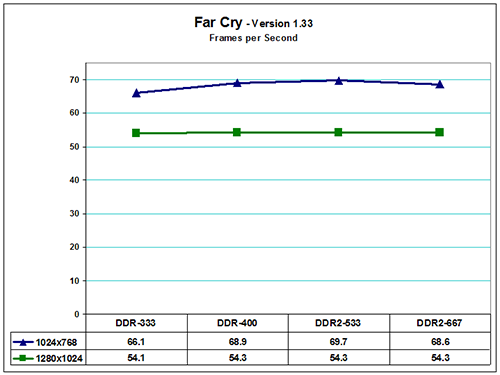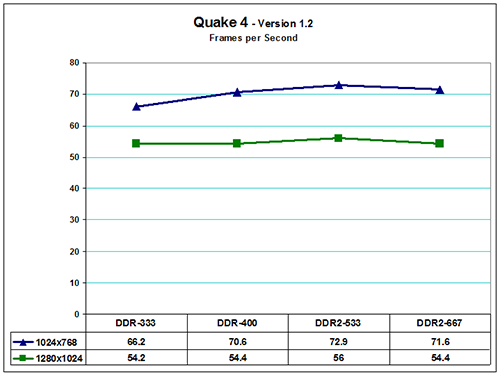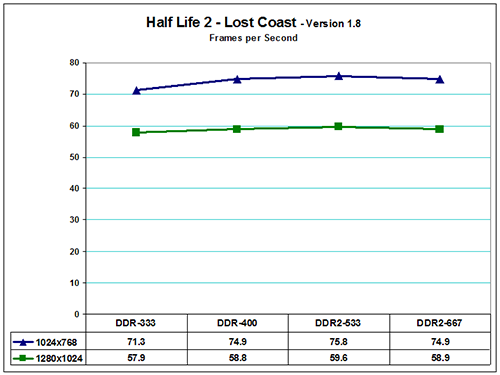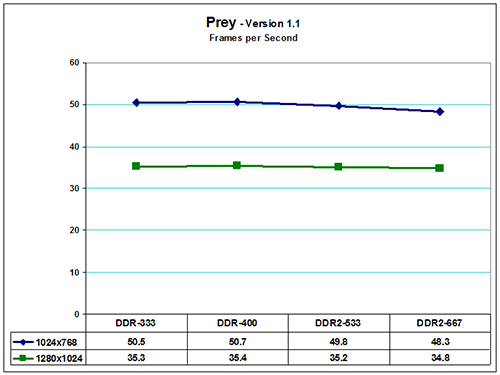ASRock 775Dual-VSTA: Does DDR2 matter?
by Gary Key on August 8, 2006 6:35 AM EST- Posted in
- Motherboards
Game Performance Comparison
While Sandra and Super Pi provide useful information on how memory performs without the influence of other components, our first round of real world tests has shown there is not a large difference in performance between DDR2 and DDR memory on this particular platform. However, our next set of real-world benchmarks consists of gaming benchmarks.
We utilize Far Cry, Half-Life 2 and Quake 4 in our normal memory testing because they are sensitive to memory changes. We are adding Prey and Serious Sam II to our benchmark mix because they are typically very GPU dependent and we will see the effects of our memory choices on these games. We tested at both 1024x768 and 1280x1024 at High Quality settings but without anti-aliasing or antistrophic filtering enabled. We feel like these settings are representative of a platform at this price point and believe most users would be utilizing a 17" or 19" monitor with this setup.





Our three memory sensitive games show a slight difference in results at 1024x768 but are GPU limited at 1280x1024 for all intents and purposes. The performance pattern is similar to the synthetic benchmarks with the DDR2-533 setting performing best overall. The DDR2-667 and DDR-400 configurations basically end in a tie with the DDR-333 finishing last. Our two GPU limited games actually favor the DDR-400 memory setup although the scores across the board are well within our margin of test error.
Overall, gaming performance is fine with low latency DDR-400 memory on this platform. Even DDR-333 provides for acceptable performance, particularly if you're looking to upgrade from an old socket A or 478 system. In that case, you might also want a new GPU, but we'll take a look at PCIe vs. AGP performance in part two of this series.
While Sandra and Super Pi provide useful information on how memory performs without the influence of other components, our first round of real world tests has shown there is not a large difference in performance between DDR2 and DDR memory on this particular platform. However, our next set of real-world benchmarks consists of gaming benchmarks.
We utilize Far Cry, Half-Life 2 and Quake 4 in our normal memory testing because they are sensitive to memory changes. We are adding Prey and Serious Sam II to our benchmark mix because they are typically very GPU dependent and we will see the effects of our memory choices on these games. We tested at both 1024x768 and 1280x1024 at High Quality settings but without anti-aliasing or antistrophic filtering enabled. We feel like these settings are representative of a platform at this price point and believe most users would be utilizing a 17" or 19" monitor with this setup.





Our three memory sensitive games show a slight difference in results at 1024x768 but are GPU limited at 1280x1024 for all intents and purposes. The performance pattern is similar to the synthetic benchmarks with the DDR2-533 setting performing best overall. The DDR2-667 and DDR-400 configurations basically end in a tie with the DDR-333 finishing last. Our two GPU limited games actually favor the DDR-400 memory setup although the scores across the board are well within our margin of test error.
Overall, gaming performance is fine with low latency DDR-400 memory on this platform. Even DDR-333 provides for acceptable performance, particularly if you're looking to upgrade from an old socket A or 478 system. In that case, you might also want a new GPU, but we'll take a look at PCIe vs. AGP performance in part two of this series.










55 Comments
View All Comments
Kougar - Tuesday, August 8, 2006 - link
They mention the OCing details in their Conroe: Feeding the Monster article. IIRC this board was about 300FSB give or take 5. Not bad, considering the nForce4 & 5 series maxes out at 320 tops!poohbear - Tuesday, August 8, 2006 - link
thanks for this great article, i hope ASrock's efforts w/ PCI-E/agp and ddr/ddr2 solutions gets noticed by some of the big dogs cause im still using my ASrock Dualsata2 and intend on keeping it for my upgrade to dualcore and hang on to it for atleast another year. After that, looks like i'll keep my DDR memory and head on over to the Core duo camp. ASrock really knows how to squeeze the life outta all your components especially since most of these "upgrades" like DDR-DDR2 and AGP-PCI-E do NOT provide ANY performance improvements. just marketing BS so these companies can sell hardware.:(Calin - Wednesday, August 9, 2006 - link
Moving from DDR to DDR2 allows you to buy cheaper components (a bit cheaper). As for AGP and PCI-E, top of the line cards are PCI-E, on AGP you can find only mainstream (maybe because PCI-E x16 gives more juice to the card than AGP can?)poohbear - Wednesday, August 9, 2006 - link
erm, moving to ddr2 isnt cheaper if i hafta ditch my 1gb of ddr ram.;) as for the PCI-E, im taking about bandwidth wise, PCI-E hasnt offered any performance increases at all. Sure, what's available now is only high end PCI-E, but if they did make a high end 7900GTX in AGP im sure it wouldnt perform 1 fps less than the PCI-E version. AGP8x was simply never saturated enough.saiku - Tuesday, August 8, 2006 - link
Yes!! I would love to know if I can bring over my AGP 6800GT and my 2 GB of Ram from my Socket 754 world to the Core 2 Duo platform. Great article !!Anandtech, just when I thought that you had stopped caring about the "common man", here comes this great article !
Thank you for remembering those of us who don't spend 500 bucks on 2 GB of RAM !!
Rike - Tuesday, August 8, 2006 - link
Second that. Thanks, for looking out for those of us who still have some tight budgets.VooDooAddict - Tuesday, August 8, 2006 - link
What I find interesting is that even DDR-333 works very well on the platform.This makes it tempting to upgrade my existing Dual Xeon 2.66 to Core 2 Duo. It's got 2 gigs of low latency (2-2-2-5) DDR-333.
VooDooAddict - Tuesday, August 8, 2006 - link
Also looking forward to the PCIe / AGP comparison.KingofL337 - Tuesday, August 8, 2006 - link
Does this board allow for any overclocking at all?Gary Key - Tuesday, August 8, 2006 - link
Yes, figure about 10~15% on average. There is not a VCore adjustment on the board and it is limited already due to design.